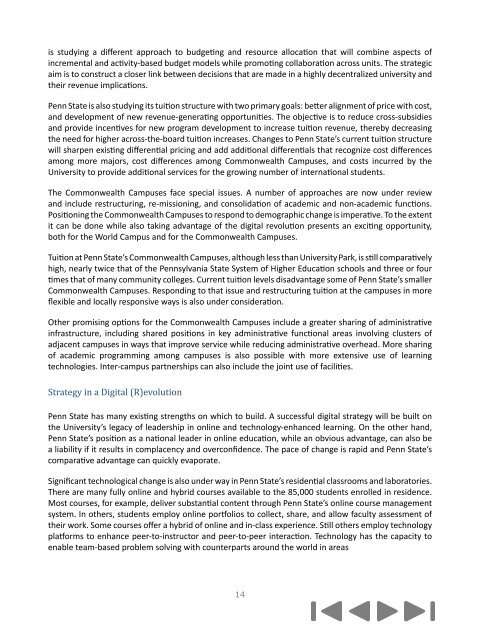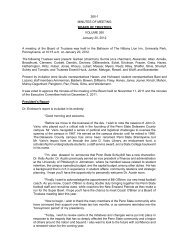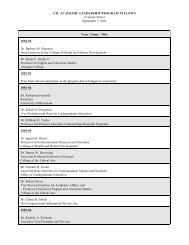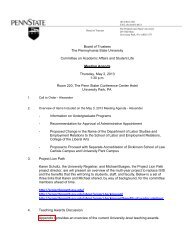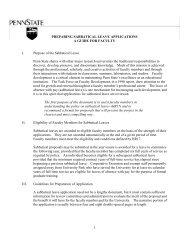A VISION FOR PENN STATE - Penn State University
A VISION FOR PENN STATE - Penn State University
A VISION FOR PENN STATE - Penn State University
Create successful ePaper yourself
Turn your PDF publications into a flip-book with our unique Google optimized e-Paper software.
is studying a different approach to budgeting and resource allocation that will combine aspects of<br />
incremental and activity-based budget models while promoting collaboration across units. The strategic<br />
aim is to construct a closer link between decisions that are made in a highly decentralized university and<br />
their revenue implications.<br />
<strong>Penn</strong> <strong>State</strong> is also studying its tuition structure with two primary goals: better alignment of price with cost,<br />
and development of new revenue-generating opportunities. The objective is to reduce cross-subsidies<br />
and provide incentives for new program development to increase tuition revenue, thereby decreasing<br />
the need for higher across-the-board tuition increases. Changes to <strong>Penn</strong> <strong>State</strong>’s current tuition structure<br />
will sharpen existing differential pricing and add additional differentials that recognize cost differences<br />
among more majors, cost differences among Commonwealth Campuses, and costs incurred by the<br />
<strong>University</strong> to provide additional services for the growing number of international students.<br />
The Commonwealth Campuses face special issues. A number of approaches are now under review<br />
and include restructuring, re-missioning, and consolidation of academic and non-academic functions.<br />
Positioning the Commonwealth Campuses to respond to demographic change is imperative. To the extent<br />
it can be done while also taking advantage of the digital revolution presents an exciting opportunity,<br />
both for the World Campus and for the Commonwealth Campuses.<br />
Tuition at <strong>Penn</strong> <strong>State</strong>’s Commonwealth Campuses, although less than <strong>University</strong> Park, is still comparatively<br />
high, nearly twice that of the <strong>Penn</strong>sylvania <strong>State</strong> System of Higher Education schools and three or four<br />
times that of many community colleges. Current tuition levels disadvantage some of <strong>Penn</strong> <strong>State</strong>’s smaller<br />
Commonwealth Campuses. Responding to that issue and restructuring tuition at the campuses in more<br />
flexible and locally responsive ways is also under consideration.<br />
Other promising options for the Commonwealth Campuses include a greater sharing of administrative<br />
infrastructure, including shared positions in key administrative functional areas involving clusters of<br />
adjacent campuses in ways that improve service while reducing administrative overhead. More sharing<br />
of academic programming among campuses is also possible with more extensive use of learning<br />
technologies. Inter-campus partnerships can also include the joint use of facilities.<br />
Strategy in a Digital (R)evolution<br />
<strong>Penn</strong> <strong>State</strong> has many existing strengths on which to build. A successful digital strategy will be built on<br />
the <strong>University</strong>’s legacy of leadership in online and technology-enhanced learning. On the other hand,<br />
<strong>Penn</strong> <strong>State</strong>’s position as a national leader in online education, while an obvious advantage, can also be<br />
a liability if it results in complacency and overconfidence. The pace of change is rapid and <strong>Penn</strong> <strong>State</strong>’s<br />
comparative advantage can quickly evaporate.<br />
Significant technological change is also under way in <strong>Penn</strong> <strong>State</strong>’s residential classrooms and laboratories.<br />
There are many fully online and hybrid courses available to the 85,000 students enrolled in residence.<br />
Most courses, for example, deliver substantial content through <strong>Penn</strong> <strong>State</strong>’s online course management<br />
system. In others, students employ online portfolios to collect, share, and allow faculty assessment of<br />
their work. Some courses offer a hybrid of online and in-class experience. Still others employ technology<br />
platforms to enhance peer-to-instructor and peer-to-peer interaction. Technology has the capacity to<br />
enable team-based problem solving with counterparts around the world in areas<br />
14


